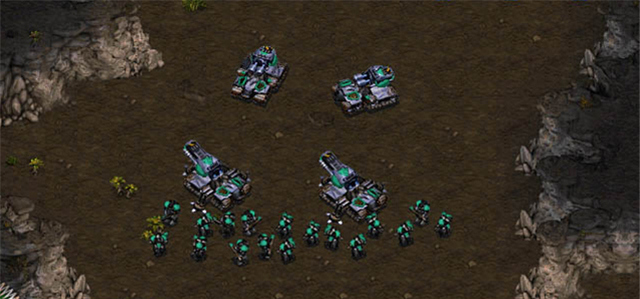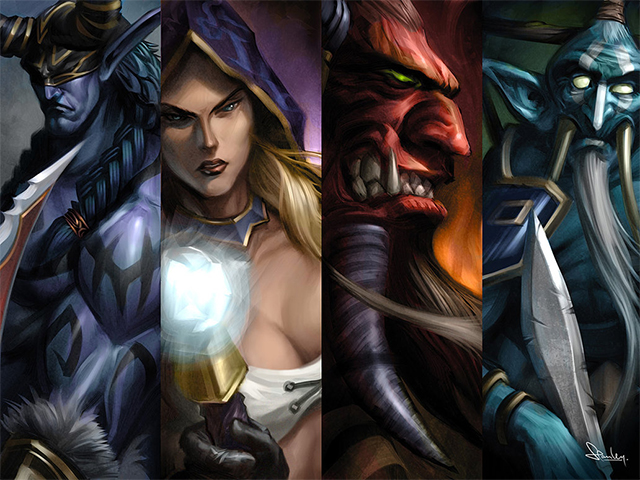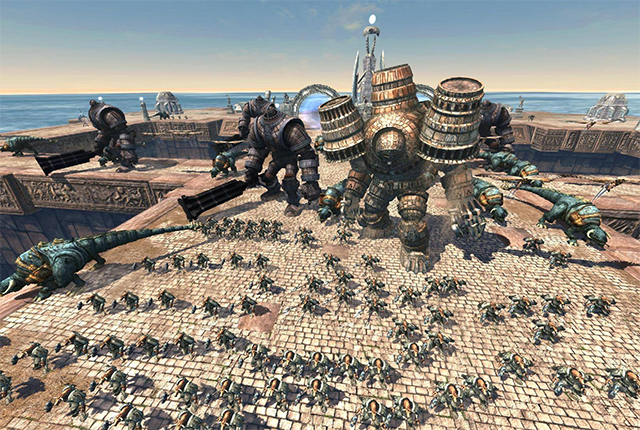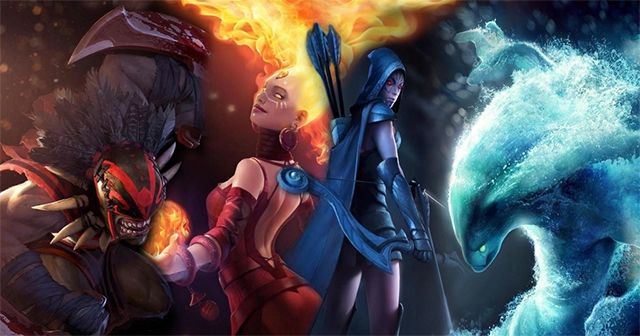/cdn.vox-cdn.com/uploads/chorus_image/image/18694329/league_of_legends_negativity.0.jpg)
This past weekend at PAX Prime in Seattle, North America's top professional League of Legends teams fought for the chance to play in this month's World Championship tournament, with newcomers Cloud 9 and Vulcun Techbargains winning big alongside old guard holdout TSM Snapdragon. Starting on Sept. 15, the best teams from all over the world will compete in playoffs leading to the grand finals on Oct. 4 at Los Angeles' Staples Center. Millions of dollars are at stake, and millions of viewers will tune in to watch what might be the biggest eSports event in history.
It's hard to deny that gaming is in the age of the MOBA. Valve's Dota 2 is the most popular game on its Steam service; League of Legends is arguably the most popular game in the world. How did a genre that started from the humblest of beginnings — a genre whose definition and even very name is in dispute — come to take an industry by storm? It started with Blizzard's seminal real-time strategy game, StarCraft.

With Strange Aeons
The Players: Blizzard, "Aeon64"
The Game: StarCraft (1998)
The Mod: Aeon of Strife
Blizzard Entertainment was known for providing tools for its players to create their own customized maps for use in its real-time strategy titles. Some popular maps in StarCraft made it easier to harvest resources in order to create massive armies of powerful units more quickly. One map that took the opposite approach was Aeon of Strife.
Created by a mapmaker known only as Aeon64, Aeon of Strife tasked players with controlling a single powerful unit rather than an army. A quartet of players fought alongside weaker computer-controlled units against the computer, and the game ended if critical buildings inside either team’s base were destroyed or if all four players died. A subsequent update to the map enabled PvP combat, pitting four players against each other in a two-on-two bout. Aeon of Strife developed a devoted, if small, following, never quite setting the world on fire.
What Aeon of Strife did do was create a familiar framework, and in doing so, struck the smallest of sparks. The release of a new Blizzard game with a more powerful map editor would fan the flames.

Tower Defense
The Players: Blizzard, "Eul"
The Game: Warcraft 3: Reign of Chaos (2002)
The Mod: Defense of the Ancients
Blizzard's next RTS, Warcraft 3, also included a map editor. Crucially, the game itself, though primarily an RTS, also included RPG elements. Combat was no longer solely the domain of armies; in Warcraft 3 it revolved around "heroes," powerful individual units that leveled up over time, had unique skills, and could be equipped with items. The editor also enabled would-be modders to create their own heroes with original spells and abilities, meaning that they weren’t limited only by the heroes provided by the game.
A mapmaker named Eul took advantage of these new tools to recreate Aeon of Strife in this new game, and used the Night Elf "Ancient" tree structures as the critical buildings in the players’ bases. As the objective of the map was to destroy the opponent's Ancient while protecting your own, Eul called his new map Defense of the Ancients. It became moderately popular in the custom game scene, though its players found it easier to abbreviate it to an acronym: DOTA.
After his attempt to make a DOTA sequel map following the release of The Frozen Throne ultimately flopped, Eul decided to make his map code open-source to allow other mapmakers to try their hand at improving upon his work.

You're An All-Star
The Players: Steve "Guinsoo" Feak, "IceFrog"
The Game: Warcraft 3: The Frozen Throne (2003)
The Mod: DOTA Allstars
With the release of Warcraft 3's expansion The Frozen Throne in 2003, Blizzard added a significantly more powerful map editor to the RTS. Enterprising mapmakers used the opportunity to upgrade Eul's original Defense of the Ancients, with dozens of versions adding their own playable hero characters.
These various disparate versions of DOTA were eventually combined in one "All-Stars" map by two mapmakers named Meian and Ragn0r, which found itself in the curating hands of a modder named Steve Feak, or Guinsoo. Guinsoo refocused Allstars on team-versus-team PvP battles and streamlined many of the more cumbersome elements of the original.
Unlike Aeon of Strife or even the original DOTA, Feak's DOTA Allstars was a wild hit, soon crowding out almost every other custom map in Blizzard's Battle.net service and developing a thriving community with entire websites devoted to it.
In 2005, Feak handed off Allstars to a fellow mapmaker and modder named IceFrog. It was under IceFrog's direction and keen eye for competitive balance that DOTA Allstars reached its greatest popularity, and even saw official tournament events at BlizzCon. For many fans, the reclusive IceFrog and DOTA were synonymous.
For all of its popularity, DOTA Allstars was still a custom map in someone else's game. Players were forced to download the latest versions from external sources, there was no tutorial or introduction, and matchmaking had to be done entirely manually. But the genre was growing too big to ignore.

Branching Out: The First Wave
The Players: Gas Powered Games, Steve "Guinsoo" Feak & Riot Games, S2 Games
The Games: Demigod (2009), League of Legends (2009), Heroes of Newerth (2010)
The first commercial stand-alone title using the DOTA formula was Gas Powered Games' Demigod, which offered new gameplay modes and multiple maps. Unfortunately for Demigod, it launched with only 8 playable characters when DOTA players were accustomed to having dozens and dozens to choose from. Even more unfortunately for Demigod, its overburdened multiplayer servers frequently failed.
S2 Games' Heroes of Newerth was far more faithful to the DOTA formula than Demigod had been, and had dozens of heroes to boot, many of whom had been practically lifted out of the Warcraft 3 map. Though its free open beta was more popular than its eventual paid release, it still saw moderate success with hundreds of thousands of copies sold. However, it was already playing catch-up.
In late 2009, after Demigod but before Heroes of Newerth, Riot Games released its first title, a stand-alone DOTA-inspired title called League of Legends. League came with an impressive pedigree, as one of its developers was none other than DOTA: All-Stars curator Steve "Guinsoo" Feak.
Like Newerth, League featured dozens of characters and was faithful to the DOTA formula. Unlike Newerth and Demigod, League of Legends was free. Players could initially only choose from a stable of 10 characters (or "champions") that rotated every week, but could permanently purchase their favorite characters with either points earned in-game or real-money microtransactions.
Catching the upswing of the growing free-to-play market, League of Legends became a massive success. To escape forever living in the shadow of the original mod, Riot coined a new name for the genre: Multiplayer Online Battle Arena, or MOBA.

Defense of the Trademark: The Second Wave
The Players: Riot Games, Blizzard, Valve & "IceFrog"
The Games: League of Legends (2009), StarCraft 2 (2010), Dota 2 (2013)
The Mods: Blizzard DOTA / Blizzard All-Stars (Development)
DOTA was unquestionably one of the most successful mods of all time, perhaps second only to the venerable Half-Life mod Counter-Strike. It was somewhat fitting, then, in October 2009 when DOTA: All-Stars developer IceFrog announced he had been hired by Half-Life studio Valve in a project he described as "great news" for fans of DOTA.
Many expected Valve to come up with its own DOTA clone with IceFrog at the helm. Fewer expected Valve to file a trademark for "Dota" in August 2010. Riot and Blizzard objected on the grounds that it should be a trademark held by the community, and expressed concern that Valve could use it to shutter the original DOTA. Riot itself filed a counter-trademark to dispute Valve's ownership of the name. At BlizzCon that year, Blizzard revealed its own Blizzard DOTA, a StarCraft 2 mod starring characters from the Warcraft, StarCraft and Diablo universes.
The legal battle was resolved out of court in 2012 with Valve retaining commercial ownership of "Dota," though allowing the community to use it in a non-commercial fashion. As part of the agreement, Blizzard renamed its own take on the genre Blizzard All-Stars.
Valve publicly unveiled Dota 2 at Gamescom 2011 with a tournament it called "The International," featuring a then-record $1.6 million in prize money. Dota 2 was presented as a direct sequel to the original Warcraft 3 map, lifting characters and items wholesale and giving them a fresh coat of paint (and changing them to not infringe on Blizzard's copyrights). After a long pseudo-closed beta test, Valve would officially launch Dota 2 as a free-to-play title in the summer of 2013.

Non-PC: The Third Wave
The Players: Uber Entertainment & Microsoft, Ronimo Games & dtp Entertainment, Monolith Productions & Warner Bros.
The Games: Monday Night Combat (2010), Awesomenauts (2012), Guardians of Middle-earth (2012)
At the time Valve laid its claim to "Dota," all of the existing DOTA clones had things in common: They were all PC games played from a top-down isometric perspective similar to that of an RTS (understandable, given the genre's origins). Indeed, Valve itself rejects the use of Riot's "MOBA" acronym for the genre, and instead calls Dota 2 an "action RTS," or "ARTS."
While the battle over the DOTA trademark was winding up, another company decided to apply the principles of the MOBA to another style of gameplay. Monday Night Combat, released on Xbox Live Arcade in 2010, was on its surface a third-person shooter. The objective, however, was to destroy the enemy's base while accompanied by smaller AI-controlled minions. It played like a shooter, but it unmistakably borrowed from DOTA's design principles.
Ronimo Games' Awesomenauts similarly applied the MOBA design to a 2D platformer, lending each stage a vertical element. Like Monday Night Combat, it was originally an Xbox Live Arcade title, though it also saw release on PlayStation Network and Steam.
In contrast, Monolith's Lord of the Rings-themed Guardians of Middle-earth attempted to bring the familiar top-down RTS-style gameplay directly to consoles. It was released in late 2012 to mixed reviews, and would eventually be ported back to PC.

Domination: The Fourth Wave
The Players: Turbine & Warner Bros., Waystone & EA, A Bit Lucky & Zynga, Trion & Petroglyph, Valve, Riot Games, and more
The Games: Infinite Crisis, Dawngate, Solstice Arena, End of Nations, Dota 2, League of Legends
Today, the MOBA genre is a phenomenon that belies its humble roots as a StarCraft custom map. MMO maker Turbine is working on a DC Universe-themed game in Infinite Crisis. Trion recently announced that Petroglyph's MMORTS End of Nations would be retooled as a MOBA. EA is publishing Waystone's Dawngate, a simplified take on the notoriously complex genre. Social-games giant Zynga is trying to simplify the genre further for mobile platforms with A Bit Lucky's Solstice Arena.
While many of these games may ultimately find their own stable niches and communities, the MOBA space is dominated by Riot's League of Legends and Valve's Dota 2. Over 4 million unique players boot up Dota 2 every month, and at peak times 400,000 of them are logged in simultaneously; that number is only growing. League of Legends is even bigger, with 32 million monthly users, 12 million daily users, and a peak concurrency of 3 million gamers around the world — numbers which have almost certainly grown since they were released in October of 2012.
The two games are stuck in a heated rivalry, the MOBA equivalent of Battlefield and Call of Duty, Unreal Tournament and Quake 3, or Mario and Sonic. Dota 2 fans accuse Riot of paying off eSports organizations to promote League over Dota, and League of Legends fans say they're just jealous of their success. This year's "The International 3" Dota 2 tournament took advantage of the heightened post-release popularity to set new viewership records; Valve says that over 1 million concurrent viewers watched the finals on sites like Twitch.tv, China’s Gamefy, and Valve’s own in-game streaming, compared to the previous year’s record of 567,000 viewers. The League of Legends Season 3 World Championship is looking to surpass last year’s record of 1.2 million concurrent viewers; a total of 18 million viewers tuned in across the All-Star weekend event in May.
Few gaming genres can claim to be as influential or lucrative as the MOBA can right now; even fewer started life as a mere custom map.